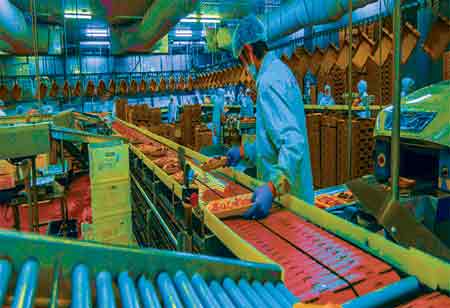

Thank you for Subscribing to Agri Business Review Weekly Brief

This advanced variant of precision farming can make farms more profitable, efficient, safe, and environment-friendly
Around 1.3 billion tonnes of food produced for human consumption—worth over USD one trillion and wasted annually—is lost or wasted globally. Similarly, every night, around 828 million people go to bed hungry. These two UN World Food statistics emphasise the fact that food loss and waste are significant factors contributing to hunger worldwide. The use of technology, such as big data analytics and AI, to increase the yield or income per acre of farmers, and to keep them involved in agriculture, is one potential answer. Precision farming has evolved into Agriculture 4.0, which has the potential to revolutionise the traditional farming sector. It alludes to the extension, acceleration, and improvement of activity efficiency along the entire production chain through the use of the Internet of Things (IoT), big data, artificial intelligence, and robotics. The method differs significantly from traditional agricultural methods, where irrigation is regulated, and pesticides or fertilisers are evenly distributed. Instead, from crop selection to determining which area of the field to produce which type of crop, farmers will need to be more focused and data-driven in all they do. Robots, temperature and moisture sensors, aerial photos, and GPS technology will all be used by farms in the future to boost productivity. Farms will become more profitable, effective, safe, and environmentally friendly thanks to these cutting-edge practices, which are collectively referred to as advanced or high-tech precision farming. Big data will play a more significant role than ever before in changing the agriculture industry and can improve the whole supply chain. A global agribusiness network's high level of connection offers numerous advantages both above and below the supply chain: Distributors can use data to source inputs and position themselves for maximum market advantage. Manufacturers can use data to enhance their production processes and more effectively target their customer bases. Farmers can use their data to apply the right products at the right rates and at the right times. Blockchain technology is also expanding, bringing about a new way for parties to interact in the supply chain: trust is built by consensus between parties and is supported by technology, doing away with the need for a middleman. The benefits of blockchain technology extend far beyond simple transactions. It can substantially increase food safety and decrease inefficiency. Improved traceability allows regulators to determine the origin of foods and gauge the severity of contamination problems. The advent of agriculture 4.0 is less likely to be widespread for several more years, but precision farming is becoming increasingly popular. The two tiers of precision farming are as follows. Whereas some farmers still employ conventional farming practices, others have started to use precision farming technologies to step up their game. The second cohort is already seeing an increase in income per acre and improved yields as a result of adopting technology. For instance, certain grape farmers have started to detect and geolocate crop illnesses or pests, enabling them to control infestations sooner and more precisely. Additionally, less toxic pesticides are applied to the crop as a result. Several modern farmers are also employing soil mapping tools to figure out how much fertiliser is best to use in their fields. Drones are also being used to apply herbicides more precisely. To better plan their harvest and increase output, sugarcane producers have started employing technology to determine when it is best to harvest their crops. Several farmers have also started to predict agricultural output, weather, and pricing trends using AI/ML-powered systems. To protect their fields from the whims of labour shortages, several farmers have also started testing self-driving tractors and seed-planting robots. The use of accurate pesticide and fertiliser treatments, improved utilisation of arable land, and sustainable agricultural practices are all possible because of precision farming. To minimise wastage, loss, or theft, it is vital to consider the logistical and warehousing components of food distribution. With the help of more effective farm decision-making that is more immediate, such as recognising pest threats earlier or preparing for severe weather events, precision agriculture enables farmers to do more with less by pinpointing the key areas of their farm that offer the best ROI for the suitable investment. With the use of intelligent data use, precision agriculture can pinpoint the areas of a farm that will generate a profit or would be better suited to achieving sustainability and conservation goals. Farmers may better understand their output techniques and determine what improvements will produce the most value by using smart data utilisation. The agriculture 4.0 movement is more than a trend. The phrase has become a catch-all for agriculture's next evolutionary step: a smarter, more effective sector that fully utilises big data and new technology to benefit the supply chain. The fourth agricultural revolution must be grounded on the idea of responsible innovation, which essentially means making sure that advancements made to boost productivity and/or eco-efficiency also have social advantages, cater to human needs, and uphold ethical standards. Experts proposed techniques to direct technology development grouped around four dimensions—anticipation, inclusion, reflexivity, and responsiveness—in the context of smart dairy farming while noting its potential relevance to other agricultural contexts.